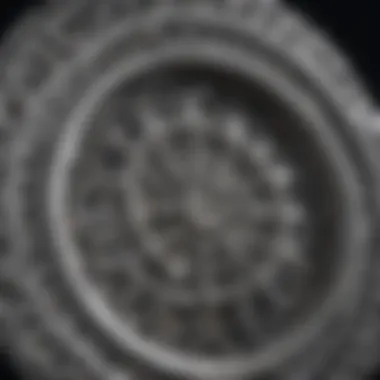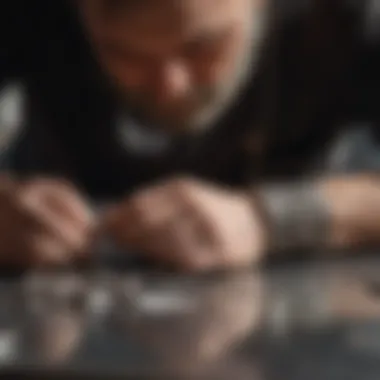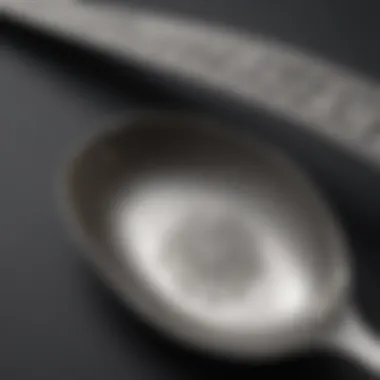Unlocking the Secrets of Mastering Silversmithing Techniques


Rock and Fossil Identification
In the world of silversmithing, understanding the materials used is fundamental. Similarly to how a geologist must identify rocks and fossils, a silversmith must be well-versed in recognizing different types of silver and other metals. This includes understanding the characteristics to look for in metals, such as purity levels, malleability, and color variations, to ensure high-quality work. Utilizing specialized tools for identification, such as metal testers and magnifying glasses, becomes essential for accurately assessing the materials being worked with.
Mastering Techniques and Tools
Within the realm of silversmithing, mastering techniques and tools is key to creating intricate and stunning pieces of silverware. Aspiring silversmiths must familiarize themselves with an array of techniques, including soldering, forging, and polishing, to craft pieces that reflect both skill and artistry. Furthermore, using specialized tools such as hammers, anvils, and metal files with precision is crucial in achieving desired shapes and finishes.
Understanding Historical Significance
Delving into the history of silversmithing offers valuable insights for artisans looking to master this ancient craft. Exploring the historical significance of silver as a precious metal, its role in various cultures and civilizations, and the evolution of silversmithing techniques throughout time provides a profound understanding of the art form. This historical context not only enriches one's knowledge but also serves as inspiration for creating pieces that honor tradition while incorporating modern influences.
Crafting Techniques with Precision
The art of silversmithing requires unrivaled precision in metalwork, akin to the intricate processes involved in geological formations. From shaping silver into delicate designs to meticulously soldering components together, every step demands meticulous attention to detail. Similar to a geologist meticulously examining rock formations, a silversmith must approach their work with precision and care to produce pieces of enduring beauty and quality.
The Intersection of Art and Science
Embarking on the journey of learning silversmithing involves a harmonious blend of artistic flair and scientific rigor. Just as a geologist combines scientific knowledge with a keen eye for patterns in rocks and fossils, a silversmith must merge technical expertise with a creative vision when working with silver. This intersection of art and science elevates the craft of silversmithing, turning each piece created into a masterpiece that speaks to both the intellect and the soul.
Introduction to Silversmithing
As we embark on this journey into the intricate world of silversmithing, it is essential to understand the foundational aspects that shape this ancient craft. The section on 'Introduction to Silversmithing' sets the stage for aspiring artisans to grasp the significance of this art form. By delving into the historical significance and modern influences of silversmithing, enthusiasts gain a holistic perspective that paves the way for mastery.
Historical Significance
The Evolution of Silversmithing
The Evolution of Silversmithing stands as a testament to the resilience and artistry of generations past. This aspect of silversmithing charts the progression of techniques and styles, showcasing how the craft has evolved over centuries. Understanding this evolution offers insights into the foundation upon which contemporary silversmiths build their expertise. The key characteristic of this evolution lies in its adaptability to changing times and tastes, making it a valuable exploration in this article. By studying The Evolution of Silversmithing, artisans can adapt age-old techniques to modern practices, bridging tradition with innovation.
Ancient Techniques and Traditions
Ancient Techniques and Traditions form the core of silversmithing's heritage, embodying the wisdom of craftsmanship handed down through antiquity. These techniques bear the marks of cultural influences and artisanal ingenuity, reflecting the dedication to excellence prevalent in historical silversmithing. By embracing Ancient Techniques and Traditions, aspiring silversmiths connect with the roots of their art, drawing inspiration from time-honored practices. The unique feature of these techniques lies in their time-tested efficacy, offering artisans a repertoire of skills that withstand the test of time.
Modern Influences
Contemporary Trends in Silversmithing
Amidst the rich tapestry of silversmithing, Contemporary Trends emerge as beacons of innovation and creativity. This aspect explores how modern artisans infuse their work with contemporary aesthetics, blending tradition with a modern sensibility. The key characteristic of Contemporary Trends in Silversmithing lies in their ability to push boundaries and redefine the art form for the 21st century. By embracing these trends, artisans can stay abreast of evolving tastes and preferences, ensuring their work remains relevant and engaging.


Integration of Technology
In an era defined by technological advancements, the Integration of Technology into silversmithing represents a paradigm shift in craftsmanship. This aspect delves into how tools like 3D printing and laser cutting revolutionize the production process, offering artisans new avenues for exploration. The key characteristic of this integration lies in its ability to enhance precision and efficiency, streamlining complex tasks with the aid of modern technology. By leveraging technological advancements, silversmiths can expand their creative horizons and elevate their work to new heights.
Essential Tools and Materials
Silversmithing, an intricate craft with centuries of tradition, requires a meticulous selection of essential tools and materials crucial for honing skills and creating exquisite pieces of art. Understanding the importance of tools and materials in silversmithing is paramount for any aspiring artisan embarking on this journey. Without the proper tools and quality materials, achieving precision in metalwork and mastering this timeless craft would be a challenging feat.
Metalworking Tools
Metalworking tools are the backbone of silversmithing, enabling artisans to shape, design, and manipulate metals with precision and finesse. Two quintessential tools that stand out in a silversmith's arsenal are the anvil and hammer and soldering equipment.
Anvil and Hammer
The anvil and hammer play a pivotal role in the shaping and forming of precious metals, allowing artisans to craft intricate designs and textures on their creations. The anvil provides a solid surface for hammering and shaping metals, while the hammer, with its varied faces and weights, imparts specific textures and forms to the metal. Artisans rely on the distinct sound and feel of the hammer hitting the anvil to gauge the metal's malleability and workability, a skill honed through practice and experience. The traditional appeal and versatility of the anvil and hammer make them indispensable tools in the silversmith's workshop, offering precision and control in metalworking.
Soldering Equipment
Soldering equipment is essential for joining metals through the application of heat and a filler metal, creating seamless connections in silversmithing projects. The soldering iron, flux, solder, and heat source are key components of soldering equipment that enable artisans to fuse metals together effectively. The controlled application of heat during the soldering process is critical to prevent damage to the metal and ensure a strong bond between the joined pieces. Versatility, precision, and ease of use are key advantages of soldering equipment in silversmithing, allowing artisans to create intricate designs and connections with finesse.
Quality Materials
Quality materials, such as precious metals, gemstones, and enamel, elevate the aesthetic and intrinsic value of silversmithing creations, adding depth and character to each piece. The selection of materials plays a significant role in achieving desired designs and aesthetics in silversmithing.
Precious Metals
Precious metals like silver, gold, and platinum are prized for their luster, durability, and malleability, making them ideal choices for silversmithing projects. Silver, in particular, is a favored metal among artisans for its affordability and versatility in creating both modern and traditional pieces. Gold and platinum, with their exquisite sheen and value, add a luxurious touch to high-end silversmithing creations. The intrinsic value and workability of precious metals make them sought-after materials in the world of silversmithing.
Gemstones and Enamel
Gemstones and enamel are decorative elements that enhance the beauty and allure of silversmithing creations, adding color, texture, and visual interest to jewelry and decorative pieces. Gemstones like diamonds, emeralds, and sapphires are prized for their brilliance and rarity, serving as focal points or accents in intricate designs. Enamel, a colored glass powder fused onto metal surfaces, creates vibrant patterns and finishes, enriching the aesthetic appeal of silversmithing works. The versatility and enduring beauty of gemstones and enamel make them essential materials for artisans seeking to elevate their silversmithing endeavors.
Fundamental Techniques
When delving into the world of silversmithing, mastering fundamental techniques is paramount. These techniques serve as the building blocks for all intricate creations, requiring precision and skill. In this section, we will explore the significance of fundamental techniques in the realm of silversmithing, emphasizing their role in shaping the final masterpiece.
Forming and Shaping
Forming and shaping are two essential aspects of silversmithing that dictate the final outcome of a piece. Whether it's raising or forging, each technique brings its unique contribution to the craft.
Raising


Raising is a technique that involves hammering metal against a stake or mandrel to form a three-dimensional shape. The key characteristic of raising lies in its ability to create depth and volume in a piece, adding intricate textures and curves that define fine silversmithing. Artisans often choose raising for its versatility in shaping various forms, whether it's a vase, bowl, or jewelry piece. The unique feature of raising is the gradual transformation of a flat piece of metal into a sculptural object, showcasing the silversmith's expertise. While raising offers immense creative opportunities, it requires patience and meticulous attention to detail to achieve seamless results.
Forging
Forging is another fundamental technique in silversmithing that involves shaping metal through repeated hammering and heating. The key characteristic of forging is the controlled deformation of metal to achieve desired forms and textures. Artisans favor forging for its ability to create strong and durable pieces, such as rings, bracelets, and decorative elements. The unique feature of forging lies in the manual manipulation of metal, allowing artisans to imprint their artistic style and incorporate organic textures. While forging offers resilience and distinctive aesthetics, it demands physical strength and understanding of metal properties to execute precise and refined designs.
Joining and Assembly
Joining and assembly are crucial steps in silversmithing that bring individual components together to form a cohesive whole. Techniques like soldering and riveting play a vital role in connecting metal pieces seamlessly.
Soldering
Soldering is a technique that involves using a metal alloy to join two or more metal parts together. The key characteristic of soldering is its ability to create strong and imperceptible bonds, essential for intricate silversmithing projects. Artisans appreciate soldering for its precision and reliability in fusing delicate components without compromising the overall design. The unique feature of soldering lies in the versatility of solder types and techniques, allowing artisans to adapt to various project requirements. While soldering offers seamless connections and intricate detailing, it necessitates proficiency in heat control and flux application to achieve flawless joins.
Riveting
Riveting is a joining technique that involves fastening metal parts using metal pins or rivets. The key characteristic of riveting is its mechanical strength and decorative potential, ideal for securing structural elements and embellishments in silversmithing. Artisans often choose riveting for its ability to add visual interest and structural integrity to their creations. The unique feature of riveting lies in the exposed metal connections, offering a design element that enhances the overall aesthetic. While riveting offers durability and design flexibility, it requires precision drilling and riveting skills to ensure secure and aesthetically pleasing results.
Advanced Skills and Artistry
In the realm of silversmithing, advancing to the level of artistry requires honing advanced skills that elevate craftsmanship to new heights. Within the context of this article, delving into advanced skills and artistry unveils a world of intricate techniques and refined mastery that set artisans apart in their craft. By focusing on developing these advanced skills, aspirants can transcend conventional silversmithing practices and create truly exceptional pieces of art. The importance of mastering advanced skills and artistry lies in the ability to push creative boundaries, infuse intricate details, and showcase a higher level of craftsmanship that resonates with connoisseurs of fine jewelry and metalwork. By delving into advanced skills such as engraving and texturing, silversmiths can add layers of depth and sophistication to their creations, making them stand out in a competitive market. The benefits of mastering advanced skills in silversmithing include the capacity to create bespoke pieces that tell a story, demonstrate ingenuity and attention to detail, and command admiration for the artisan’s technical prowess. Additionally, embracing advanced techniques broadens an artisan's creative horizons, allowing them to experiment with different textures, engravings, and settings that enhance the aesthetic appeal and market value of their creations.
Engraving and Texturing
Chasing:
Chasing in silversmithing refers to the meticulous technique of creating detailed designs or patterns by hammering and pushing metal from the front to the back. This ancient art form dates back to centuries ago and continues to be a popular choice among contemporary silversmiths due to its ability to add intricate motifs and textures to metalwork. The key characteristic of chasing lies in its precision and control over shaping metal, allowing artisans to bring their artistic vision to life with impeccable detail. Silversmiths often opt for chasing in this article because it enables them to personalize each piece, infusing it with a unique touch that sets their work apart from mass-produced items. One of the unique features of chasing is its versatility in creating both subtle textures and elaborate designs, offering artists a wide range of creative possibilities. While the advantages of chasing include the ability to customize designs, add depth and dimension to metal surfaces, and achieve intricate detailing, its main disadvantage lies in the time-consuming nature of this technique, requiring patience and a steady hand to master.
Repoussé:
Repoussé, another advanced technique in silversmithing, involves creating intricate patterns and shapes by hammering metal from the back to produce a raised design on the front. This method contributes significantly to the overall artistry of silversmithing by allowing artisans to form three-dimensional reliefs and decorative elements that captivate the viewer. The key characteristic of repoussé lies in its ability to sculpt metal in a dynamic and expressive manner, transforming flat surfaces into sculptural masterpieces. Silversmiths choose repoussé for this article due to its timeless appeal and the depth of dimension it brings to their creations. The unique feature of repoussé lies in its capacity to produce bold, tactile surfaces that engage the senses and invite exploration. While the advantages of repoussé include the ability to create dramatic effects, intricate embellishments, and visually striking pieces, its main disadvantage stems from the skill and strength required to manipulate the metal effectively in creating raised designs.
Stone Setting
Prong Setting:
Prong setting, a popular technique in silversmithing, involves securing gemstones in a metal framework using slender metal claws or prongs. This method contributes to the overall aesthetic appeal of jewelry by showcasing gemstones prominently and allowing light to enter from various angles, enhancing their brilliance. The key characteristic of prong setting lies in its ability to hold gemstones securely while maximizing their visibility and brilliance, making it a preferred choice for artisans looking to highlight exquisite stones. Silversmiths opt for prong setting in this article because it offers versatility in showcasing different gem shapes and sizes, allowing for creative designs that accentuate the beauty of each stone. The unique feature of prong setting is its minimalistic approach, which focuses on emphasizing the gemstone itself without overshadowing its natural beauty. While the advantages of prong setting include excellent light exposure for gemstones, easy maintenance, and a light, airy appearance, its main disadvantage revolved around the potential risks of loosening or snagging the prongs, requiring regular inspection and maintenance to prevent damage.
Bezel Setting:


Bezel setting, another popular choice in silversmithing, involves enclosing gemstones within a metal collar that wraps around the stone's perimeter, holding it securely in place. This setting style contributes to the overall elegance and sophistication of jewelry by creating a seamless border around the gemstone, enhancing its durability and aesthetic appeal. The key characteristic of bezel setting lies in its capacity to protect gemstones from external damage, provide a sleek and modern look to jewelry pieces, and offer a secure setting that minimizes the risk of stone displacement. Silversmiths favor bezel setting for this article due to its versatility in accommodating various gem shapes, sizes, and types, making it a versatile choice for showcasing different stones. The unique feature of bezel setting is its clean and contemporary aesthetic, ideal for showcasing gemstones in a sleek and sophisticated manner that appeals to modern tastes. While the advantages of bezel setting include maximum protection for gemstones, a secure setting that reduces the risk of loss, and a sleek, aesthetic appearance, the main disadvantage of this technique lies in the potential limitation of light exposure to the gemstone, which can affect its brilliance and sparkle.
Safety Precautions and Maintenance
In the realm of silversmithing, safety precautions and maintenance play a paramount role in ensuring the well-being of artisans and longevity of tools. This section focuses on the crucial elements that aspiring silversmiths must consider to create a safe and efficient working environment. By implementing proper safety measures and maintaining tools, artisans can enhance their craft while safeguarding their health.
Workshop Safety
Ventilation
Ventilation is an indispensable aspect of workshop safety in silversmithing. Effective ventilation systems ensure that harmful fumes and airborne particles generated during the crafting process are properly ventilated out of the workspace. The key characteristic of quality ventilation is its ability to provide a constant flow of fresh air while removing contaminants, thereby reducing the risk of respiratory issues and maintaining air quality for artisans. Utilizing ventilation systems significantly contributes to a healthier work environment, promoting productivity and well-being. Although ventilation systems require initial investment and periodic maintenance, their advantages in creating a safe workspace far outweigh any drawbacks.
Protective Gear
Protective gear is another essential component of workshop safety for silversmiths. Items such as goggles, gloves, aprons, and masks serve as protective barriers against potential injuries and exposure to harmful materials. The key characteristic of quality protective gear is its ability to provide adequate coverage and protection without hindering the artisan's mobility and dexterity. By wearing appropriate protective gear, silversmiths can minimize the risks associated with working with hot metals, chemicals, and sharp tools, ensuring a safer work experience. While protective gear may require regular cleaning and replacement, its advantages in preventing accidents and injuries make it a crucial choice for artisans navigating the intricate world of silversmithing.
Tool Care
Cleaning and Maintenance
Maintaining clean and well-maintained tools is essential for the longevity and efficiency of silversmithing equipment. Cleaning and maintenance practices involve regular inspection, removal of debris or buildup, lubrication of moving parts, and storage in proper conditions. The key characteristic of effective cleaning and maintenance is its ability to prolong the lifespan of tools, prevent rust or corrosion, and ensure optimal performance during crafting processes. By dedicating time to cleaning and maintaining tools, artisans can avoid unnecessary damages, enhance precision in their work, and ultimately save costs on frequent replacements. While cleaning and maintenance routines may appear time-consuming, the benefits of extending the lifespan and functionality of tools are invaluable in mastering the art of silversmithing.
Storage Tips
Proper storage of tools is as crucial as their usage and maintenance in the world of silversmithing. Storing tools in designated spaces, protected from moisture and extreme temperatures, preserves their integrity and functionality over time. The key characteristic of effective storage tips is the organization and labeling of tools to prevent loss, damage, or confusion during crafting sessions. By storing tools appropriately, artisans can streamline their workflow, reduce the risk of accidents, and prolong the lifespan of their equipment. Although implementing storage tips requires discipline and organization, the advantages of having tools readily accessible, organized, and well-preserved greatly benefit artisans in their mastery of silversmithing.
Mastering Silversmithing
Mastering silversmithing is the pinnacle of excellence in the realm of metalwork artistry. This section serves as the crowning achievement in the comprehensive guide to learning silversmithing. It stands as a testament to the culmination of honed skills, meticulous craftsmanship, and artistic vision. The mastery of silversmithing encapsulates the essence of blending traditional techniques with modern innovations, resulting in breathtaking creations that stand the test of time. Exploring this topic delves into the heart of what makes a silversmith truly exceptional.
Practice and Persistence
Repetition and Skill Development
Repetition and skill development are fundamental aspects of the silversmithing journey. Through dedicated practice and a commitment to refining techniques, artisans can elevate their craftsmanship to new heights. The key characteristic of repetition lies in its ability to instill muscle memory and precision in each movement, leading to consistency and mastery in metalworking. This deliberate practice fosters a deep understanding of materials and tools, enhancing the artisan's ability to translate vision into reality. While repetition demands perseverance and patience, its rewards are unparalleled in the world of silversmithing.
Learning from Mistakes
Learning from mistakes is a crucial element in the growth trajectory of any silversmith. Embracing failures as learning opportunities allows artisans to refine their skills and expand their creative horizons. The central tenet of learning from mistakes lies in its ability to cultivate resilience and adaptability within the artisan. Each setback becomes a stepping stone towards improvement, fostering a mindset of continuous learning and innovation. While acknowledging mistakes may initially seem daunting, the insights gained from these experiences propel artisans towards greater mastery and artistic evolution.
Seeking Guidance and Inspiration
Seeking guidance and inspiration serves as a beacon of light in the silversmithing journey, guiding artisans towards excellence and innovation. Mentorship plays a pivotal role in shaping an artisan's skills and perspective, offering invaluable wisdom and expertise passed down through generations. The key characteristic of mentorship lies in its ability to nurture talent, provide constructive feedback, and foster a sense of community within the silversmithing realm. Engaging with mentors not only accelerates skill development but also instills a sense of tradition and heritage in the artisan's work.
Exploring Artistic Influences
Exploring artistic influences opens doors to new realms of creativity and imagination for silversmiths. Drawing inspiration from various art forms, cultures, and historical periods enriches the artisan's work with depth and vitality. The key characteristic of exploring artistic influences is its potential to spark innovation, challenge conventions, and broaden artistic horizons. By immersing oneself in diverse sources of inspiration, artisans can infuse their creations with a unique flair and storytelling essence, creating pieces that resonate on a profound level.







